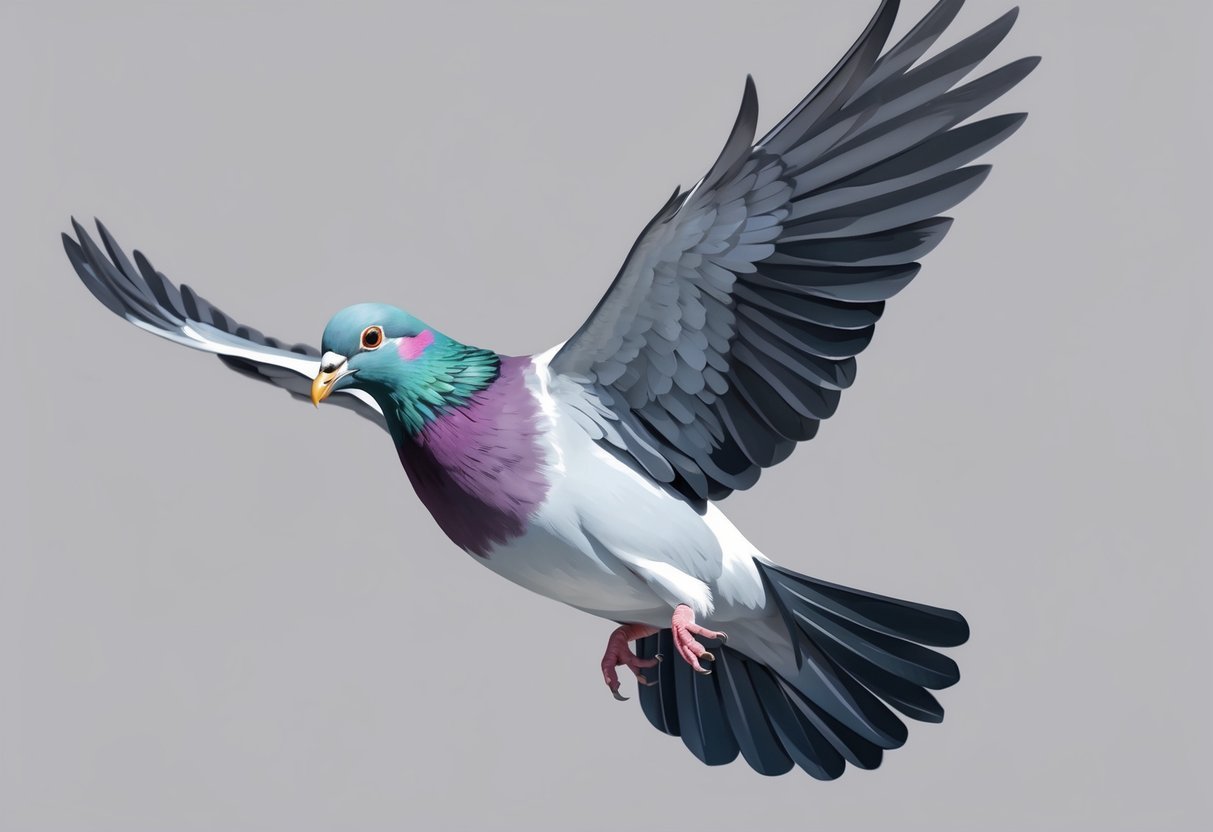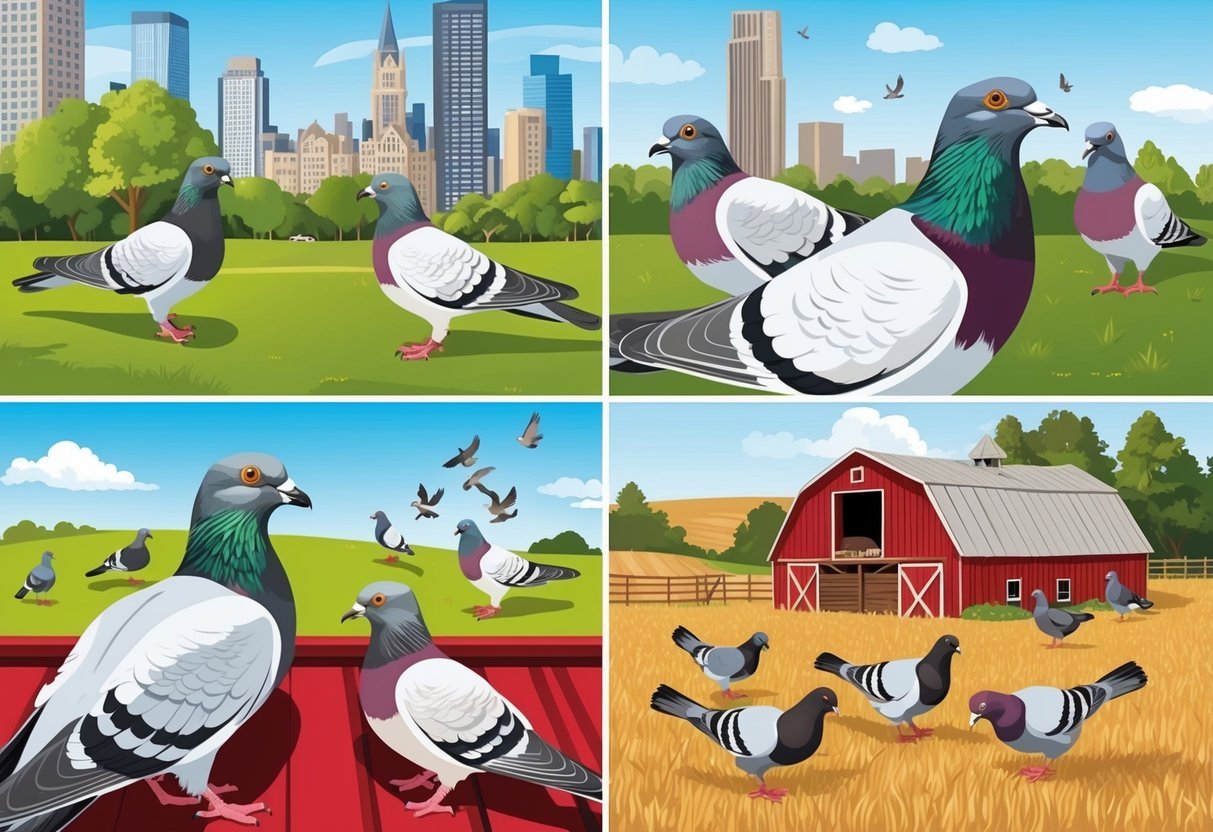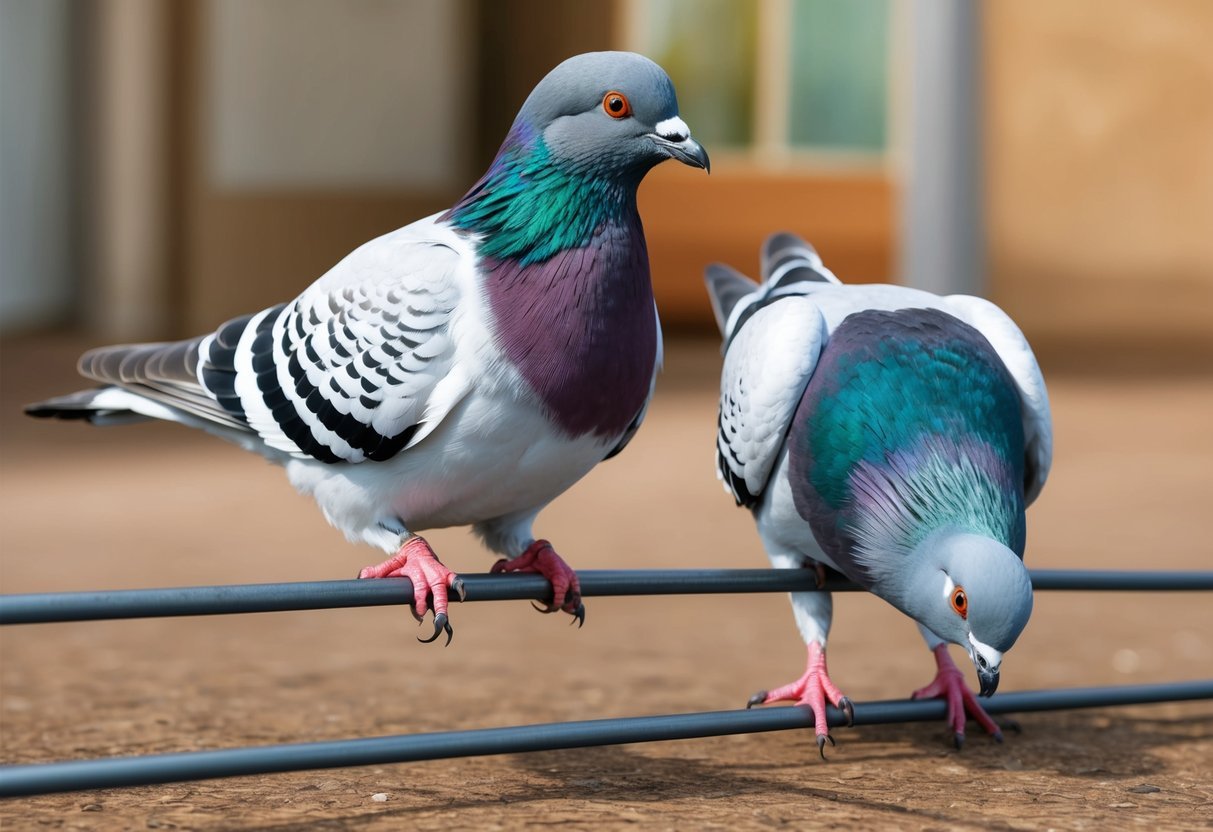Pigeons are fascinating birds with a unique way of communicating. These feathered friends use a variety of sounds to express themselves and interact with their surroundings.
Pigeons make several distinct noises. These include cooing, grunting, and wing-slapping, each serving a specific purpose in their social interactions.
The most well-known pigeon sound is their classic cooing. This gentle, rhythmic call often sounds like “coo, roo-c’too-coo” and plays a big role in attracting mates and warning off rivals.
But there’s more to pigeon communication than just cooing. These clever birds also use grunts, squeaks, and even physical sounds like wing-clapping to get their message across.
Understanding pigeon sounds can help people appreciate these common urban birds more. It’s fun to listen for different calls and try to figure out what the pigeons are saying to each other.
Whether it’s a soft coo or a sharp alarm call, each sound gives a peek into the rich social lives of these birds.
Understanding Pigeon Sounds
Pigeons use a variety of sounds to communicate. Their coos and other vocalizations have different meanings based on the situation.
The Basics of Pigeon Cooing
Pigeons are known for their soft cooing sounds. The most common coo is a deep, throaty call that sounds like “coo-COO-coo”. Male pigeons often make this noise to attract mates or claim territory.
Females also coo, but their sounds tend to be quieter. Baby pigeons make high-pitched squeaks when they’re hungry. As they grow, their voices deepen into adult coos.
Pigeons may coo more in the early morning and evening. This is when they’re most active. The sounds can carry far, helping pigeons talk to each other across long distances.
Interpreting the Variety of Coos
Pigeons use different coos for various reasons. A soft purring sound means the pigeon is happy and calm. This noise helps keep the flock peaceful.
When looking for a mate, pigeons make a moaning “ooh-ooh-ooh” sound. Paired pigeons use this call to bond at their nest too.
Pigeons also make warning sounds. A sharp “coo” can mean danger is near. Some pigeons hiss or grunt when scared or upset. Wing slaps are another way pigeons make noise, often to scare off threats.
By listening closely, people can learn a lot about what pigeons are saying to each other. Their coos and other sounds give clues about their feelings and what’s happening around them.
The Social Dynamics of Pigeon Vocalizations
Pigeons use a variety of sounds to communicate with each other. These vocalizations play a big role in how pigeons interact and form relationships within their groups.
Mating Calls and Attraction
Male pigeons make special cooing sounds to attract a mate. These soft, low-pitched calls are meant to get the attention of female pigeons. The males will often puff up their chests and strut around while cooing.
Female pigeons listen closely to these calls. They use them to pick which male they like best. A strong, clear coo can show that a male pigeon is healthy and would make a good partner.
Some male pigeons also use wing beating as part of their mating display. They clap their wings to make noise and show off to females.
Alarming Sounds and Warning Cues
Pigeons make different sounds when they sense danger. These alarm calls warn other pigeons in the group about possible threats.
A sharp, sudden grunt or squawk often means a pigeon has spotted something scary. This could be a predator or some other danger. When pigeons hear this sound, they usually take off quickly.
Flock behavior is important for pigeon safety. If one pigeon gives an alarm call, the whole group might fly away together. This helps protect them from harm.
Pigeons also use softer sounds to talk about less urgent things. A quiet grunt might mean “watch out” without causing a big panic. These gentle warnings help keep the group safe and calm.
Pigeon Communication Methods
Pigeons use a variety of clever ways to talk to each other. They make different sounds and use body movements to share information with other pigeons.
Visual and Audible Signals
Pigeons are masters of body language. They use cooing, a soft and melodic sound, to chat with their friends and find mates. When a pigeon coos, it’s like they’re saying “hello” or “I like you!”
These birds also bob their heads, puff up their feathers, and strut around to show off. It’s their way of looking cool to other pigeons. Sometimes, they even do a little dance!
Pigeons use their wings to send messages too. They might spread them wide to look big and scary if they feel threatened.
Non-vocal Sounds in Pigeon Talk
Pigeons are pretty sneaky. They can make noise without using their voices! One of their coolest tricks is the wing clap. It’s exactly what it sounds like – they clap their wings together to make a loud noise.
Wing claps can mean different things. Sometimes it’s a warning to other pigeons. Other times, it’s part of their mating dance.
Pigeons also make sounds when they fly. The whoosh of their wings can tell other pigeons how fast they’re going or if they’re in a hurry.
These birds are smart cookies. They use all these sounds and movements to share lots of info with their pigeon pals.
The Role of Flight in Pigeon Sounds

Flight plays a big part in how pigeons make sounds. Pigeons use their wings and voice to communicate while flying or taking off.
The Sound of Wings in Motion
When pigeons fly, their wings make special noises. These sounds aren’t just from moving through the air. Pigeons have modified flight feathers that produce distinctive sounds. This helps them talk to other pigeons without using their voice.
One famous wing sound is called “wing clapping”. Pigeons do this by fluttering their wings rapidly to make a clapping noise. It’s often used in mating displays to impress other pigeons.
Wing sounds also help pigeons fly together as a group. The noises let them know where other pigeons are and help them stay in formation.
Flight-Related Vocalizations
Pigeons don’t just use their wings to make noise while flying. They also use their voices.
When taking off, pigeons might make grunts or other loud noises. This can warn the flock of danger or signal it’s time to move.
In the air, pigeons coo to stay in touch with each other. These soft sounds help the flock stick together. Pigeons also have a special alarm call. If one pigeon spots danger, it can quickly alert the whole flock with this sound.
Some pigeon sounds mix with their wing beats. This creates a unique noise that other pigeons can easily recognize. It’s like each pigeon has its own flying song!
Pigeon Sounds Across Different Settings

Pigeons make different sounds depending on where they live and how their environment has changed. Their calls and noises adapt to city life and country surroundings in unique ways.
Urban Versus Rural Pigeon Sounds
City pigeons have learned to coo louder to be heard over traffic noise. Their calls are often shorter and sharper than rural pigeons. In urban areas, pigeons use more alert calls to warn the group about dangers like cars or people.
Rural pigeons have softer, longer coos. They use more varied sounds for mating and nesting. Farm pigeons make gentle sounds when feeding together. Their wing movements are quieter without city echoes.
Urban pigeons make more clicking sounds with their beaks as they move around buildings. Rural pigeons use softer sounds in open spaces. The different settings change how pigeon groups communicate.
Changes in Pigeon Sounds Over Time
Pigeon sounds have changed as cities have grown. They use higher pitches to be heard over low-frequency urban noise. Their calls are now shorter and repeated more often.
In the past, pigeons used longer, more complex songs. Now, city pigeons have simpler calls that carry further. Rural pigeons still use some older sound patterns.
Nesting sounds have changed too. Urban pigeons make more aggressive noises to defend smaller nest sites. Rural pigeons use softer sounds in their nests. Feeding calls in cities are louder to gather scattered groups.
Over time, pigeon movements have become noisier in cities. They flap harder to take off from concrete. Rural pigeons still use quiet takeoffs from soft ground.
Behavioral Context of Pigeon Sounds

Pigeons use a variety of vocalizations to communicate different behaviors and emotions. Their sounds play a key role in feeding, nesting, aggression, and contentment.
Feeding and Nesting Noises
When pigeons are feeding, they often make soft cooing sounds. This gentle noise signals to other pigeons that food is available. During nesting, parent pigeons produce unique vocalizations to communicate with their young.
The nesting calls include:
- Low, rumbling coos
- Quiet chirps
- Soft grunts
These sounds help bond the family and keep the chicks calm. As the chicks grow, they begin to make their own peeping noises to beg for food.
Sounds of Aggression and Contentment
Pigeons use distinct vocalizations to express aggression or contentment. When feeling threatened, they may make loud, harsh caws or growls. This warns other pigeons to back off.
Contented pigeons often produce a soft, soothing coo. This pleasant sound shows they feel safe and relaxed. Pigeons also “purr” by vibrating their throats. The purring noise typically means they are happy and comfortable.
During courtship, male pigeons use a variety of coos and warbles. These sounds help attract mates and show affection. The males may also make a “wing clap” noise during mating displays.
Anatomy of Pigeon Vocalizations
Pigeons make unique sounds using special parts of their body. These sounds help them talk to each other and show how they feel.
Throat and Muscle Contributions
Pigeons use their syrinx to make sounds. The syrinx is like a voice box in their chest. It has thin walls that shake when air moves through them. This shaking makes the cooing noise we hear.
Muscles around the syrinx help pigeons change their sounds. When these muscles tighten or loosen, the pitch of the coo changes. Pigeons can make their coos higher or lower this way.
The throat also plays a big role. Pigeons puff out their throat when they coo. This makes their throaty coos louder. It’s like using their body as a speaker.
Some pigeons can even make grunts. They do this by quickly pushing air out of their lungs. The fast air makes a short, rough sound.
Pigeons’ beaks stay closed when they coo. This helps shape the sound as it comes out. It’s part of what makes pigeon sounds so special.
Recording and Sharing Pigeon Sounds
Modern tech makes capturing and sharing pigeon noises easy and fun. People can now record, edit, and post these sounds online for others to enjoy or study.
Utilizing Media and Technology
To record pigeon sounds, use a smartphone or digital recorder. These devices are handy and can catch high-quality audio.
For the best results, get close to the birds without scaring them. Early morning is a good time to record, as pigeons are most vocal then.
After recording, edit the sounds with free software. Cut out background noise and boost the pigeon coos. This makes the recording clearer and more useful for listeners.
Some folks like to pair the audio with videos or photos of pigeons. This gives a full picture of the birds’ behavior. It’s fun to watch pigeons cooing and strutting while hearing their sounds.
Managing Online Content Sharing
There are many places to share pigeon sounds online. YouTube is great for longer recordings or videos. Sound-sharing sites work well for shorter clips.
When posting, add tags like “pigeon sounds” or “bird calls“. This helps others find the content easily.
It’s also nice to note the date and place of the recording.
Some sites, like Pixabay, let people share sounds for free use. This is helpful for teachers or researchers. Always check copyright rules before using or sharing sounds.
Remember to use SafeSearch settings when looking for pigeon sounds online. This keeps the search results family-friendly. It’s also good to give credit to the original recorder when sharing sounds.
Caring for Pigeons and Their Sounds
Pigeons make many sounds to communicate. Knowing these sounds helps us take better care of pigeons. It’s important to understand baby pigeon cries and manage noise in homes with pet pigeons.
Understanding Baby Pigeon Cries
Baby pigeons, called squabs, make unique sounds. They cry to get their parents’ attention. These cries sound like soft peeps or whistles.
As squabs grow, their cries get louder. This is normal and means they’re healthy. Parents respond to these cries by feeding and caring for their babies.
If you hear constant loud cries, the baby may need help. Check if it’s too hot or cold. Make sure the parents are feeding it enough.
Sometimes, hand-feeding may be needed if parents aren’t caring for the squab. But only do this if you’re sure it’s necessary.
Dealing With Noise in Domestic Settings
Pet pigeons can be noisy. Their cooing sounds are common. Males coo more, especially during mating season.
To manage noise:
- Give pigeons a quiet, dark place to sleep
- Feed them at set times to reduce food-related noise
- Use sound-absorbing materials in their living area
Some pigeons are louder than others. If noise is a big problem, consider keeping fewer birds.
Remember, pigeons use sounds to communicate. Don’t try to stop all noise. Instead, find a balance that works for you and your birds.
Cultural Perceptions and Impact
Pigeons coo in many cities, creating a peaceful urban ambience. However, some people view it as unwanted noise pollution.
In parks, pigeon calls can blend with other nature sounds to create a relaxing environment. This can help reduce stress for visitors.
But near homes or offices, frequent cooing might disrupt sleep or work. This can lead to negative feelings about pigeons.
Some cultures see pigeons as symbols of peace. Their soft sounds may evoke positive emotions. Other societies view them as pests, making their calls unwelcome.
The setting plays a big role in how people respond. A few coos in a quiet garden can be pleasant. But many pigeons on a busy street might add to urban chaos.
Human reactions also depend on personal experiences. Someone who enjoys feeding pigeons may like their sounds. A person who’s had property damage from pigeons could feel annoyed by them.

